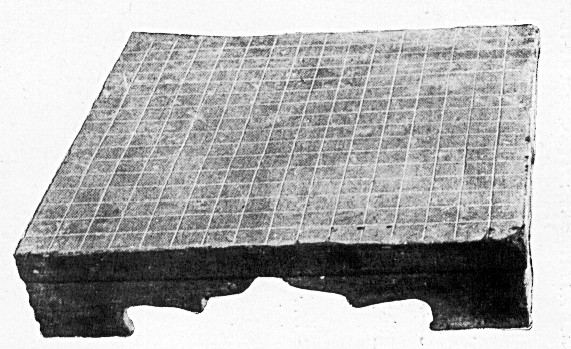BabelStone Blog
Saturday, 4 March 2006
The Origins of Go
As noted in my post on Tibetan Go, one of the features that sets Tibetan Go apart from the game played elsewhere in East Asia is that Tibetan Go is played on board with a 17 × 17 grid of 289 points, whereas in China, Japan and Korea the game is played on a board with a 19 × 19 grid of 361 points. Tibetan sources suggest that Go has been played in Tibet since at least the time of the first great Tibetan king, Srong-brtsan-sgam-po (reigned c.627-650), and this was confirmed by archaeological evidence in 2000, when a crude stone Go board was unearthed at the site of the palace where King Srongtsan Gampo was born :
Stone Go Board from Tibet
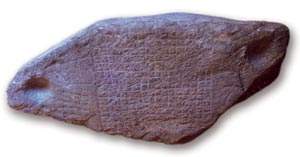
Although the game of Go outside of Tibet is now played on a 19 × 19 grid, historical records and archaeological evidence indicates that this was not always so, and that the earliest form of the game in China was actually played on a 17 × 17 grid, as in Tibet. The earliest complete Go board to have been discovered is this stone board with a 17 × 17 grid (and the five primary star points elaborately marked) that was found in 1952 in a tomb at Wangdu 望都 in Hebei province dating to the late Eastern Han period (25-220) :
Easter Han Stone Go Board (from the Wangdu Han Tomb)
Source : Wangdu Hanmu Bihua 望都漢墓壁畫 (Beijing, 1955)
(Click on image to see the face of the board)
In the 1990s this fragment of a crude pottery board was excavated from the site of the southern gate to the mausoleum of Emperor Jing Di 景帝 (reigned 156-141) and his consort at Yangling 陽陵 near Xianyang in Shaanxi province. Although the board is not associated with the main burial, it must date to the Western Han period (206-25), and so is the earliest physical evidence of the game of Go. Unfortunately it is not possible to tell whether this was a 17 × 17 board or 19 × 19 board (it has one star point marked at the lower left corner, but no star points on the sides or in the centre).
Fragment of Western Han Pottery Go Board
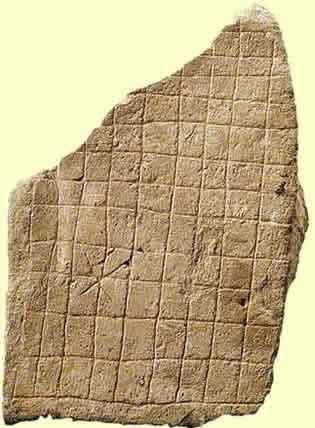
28.5 × 19.7 cm at the widest points
Source : 围棋考古 (2007-03-27)
The correspondence between Tibetan Go boards and early Chinese Go boards has led some game historians to conclude that Go originated in Tibet, and then spread to China, where the board later developed to a 19 × 19 grid. However, there is a much longer documented history of Go playing in China than there is in Tibet, and it seems more likely to me that Go originated in China, and spread to Tibet at a time when the 17 × 17 board was still in use; then due to the isolation of Tibet, Tibetan Go preserved the archaic 17 × 17 board when it was superceded by the 19 × 19 board in China and elsewhere.
As to when the game of Go first came into being, most histories of the game will tell you that it has been around for three or four thousand years, whereas in fact there is no concrete evidence for the existence of Go before about two thousand years ago. The only evidence for the game in sources dating from the 1st millenium BCE is the occasional use of the word yì 弈 "to play Go", as in this famous saying by Confucius :
子曰:“飽食終日,無所用心,難矣哉!不有博弈者乎?為之,猶賢乎已。”
Confucius said : "If you eat your full all day long, and have nothing to apply your mind to, that is disastrous ! Are there not games of chance and skill ? Would it not be better to play such games than do nothing ?"
Lun Yu 論語 "The Analects of Confucius" (Zhonghua Shuju, 1980) 17.22.
Here bó 博 is usually taken to refer to the game of Liubo 六博 (an early board game of chance in which players throw six sticks), and yì 弈 is usually taken to refer to the game of Go (a game of pure skill). Although there is not enough detail in pre-Han sources such as the Analects that mention yì 弈 to be certain that they are actually referring to the game of Go rather than some other game, Han dynasty lexical sources do confirm that yì 弈 is another name for wéiqí 圍棋. The first dictionary of Chinese characters, the Shuo Wen 說文, written by Xu Shen 許慎 in about the year 100 CE defines yì 弈 as wéiqí 圍棊, and the Fang Yan 方言, a comparative lexicon of Chinese words used in different parts of China, compiled by Yang Xiong 揚雄 (53 BCE - 18 CE) states that "Weiqi is called yi; the people east of the Hangu Pass, in the area of Qi and Lu everyone calls it yi 圍棊謂之弈。自關而東齊魯之間皆謂之弈。
Nevertheless, I am still dubious as to whether early references to yì 弈 do actually refer to the game of Go because there is a complete absence of any supporting archaelogical evidence prior to the Han dynasty. This would not be significant in itself were it not for the fact that the game of Liubo is abundantly attested in the archaeological record. Not only have dozens of Liubo boards been unearthed from Han and pre-Han tombs, but scores of Han and pre-Han murals and engravings showing people playing Liubo have been found, as well as statuettes of Liubo players.
This example of an elaborately carved stone Liubo board dates to the 4th century BCE (Warring States period) :
Liubo Board from the Warring States Period
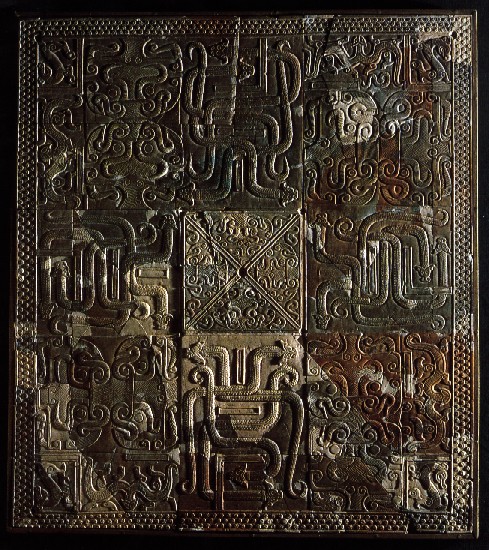
Source: Mysteries of Ancient China (British Museum, 1996) page 76.
And this is a set of wooden funerary statuettes playing Liubo (note the distinctive "TLV" pattern on the board), found in a late Western Han tomb from Gansu :
Funerary Statuettes of Liubo Players
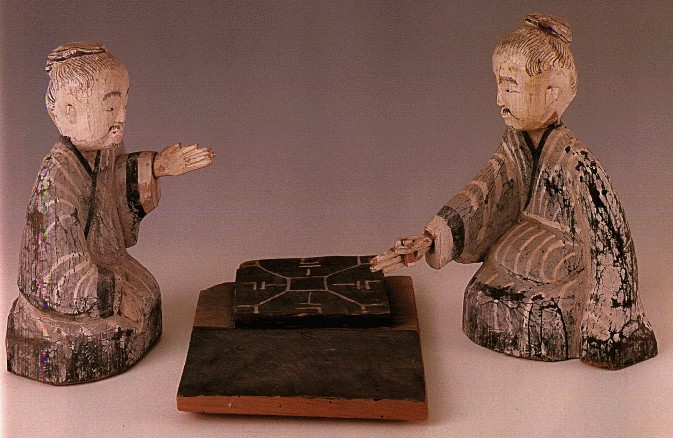
And these are couple of Han dynasty pictorial representations of people playing the Liubo :
Han Dynasty Pictorial Brick from Sichuan
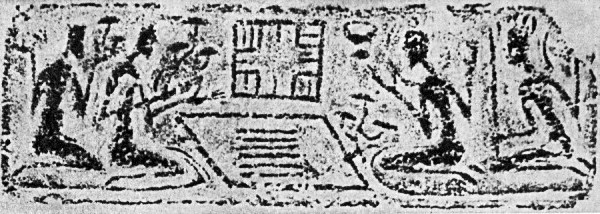
Note that the Liubo board is usually depicted to the side of the mat where the six sticks are laid out.
Han Dynasty Pictorial Stone from Jiangsu
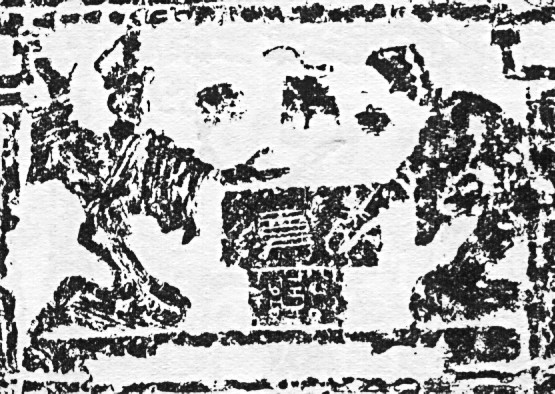
Note the typical posture of the left player, with one arm raised in readiness and the other arm stretched out towards the six sticks.
In stark contrast to the wealth of early material for Liubo, only two Han dynasty Go boards are known, and the earliest certain image of Go-playing does not occur until post-Han. The picture below is the left side panel of an illustrated stone monument depicting the life of Buddha that dates to the Northern Qi (550-577). The board shown is probably a Go board, although it only has an 11 × 11 grid, but this might be simply because there was not enough room to engrave more lines.
Northern Qi Stone Monument depicting the Life of Buddha
北齊周榮祖造像碑
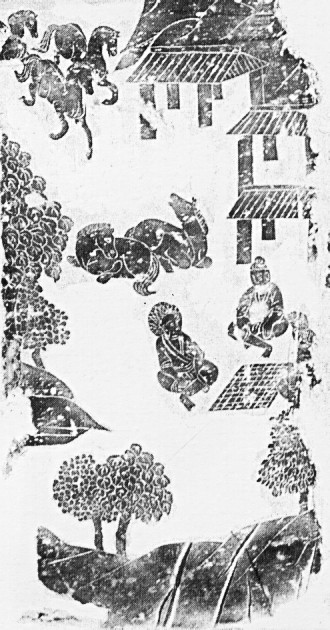
Source : Zhongguo Meishu Quanji 中國美術全集 (繪畫編) vol.19 plate 26
To my mind, this suggests that Go may not have been invented until the Han dynasty. At any rate, once Go became popular it quickly supplanted Liubo. There is virtually no evidence of Liubo being played post-Han, and it seems to have become extinct within a few generations of the rise to prominence of Go. The precise rules of Liubo are now long since lost.
The earliest unambiguous references to the game of Go are not found until the Eastern Han dynasty, and the first complete description of the game is in the work Yi Jing 藝經 "Classic of Arts" by Handan Chun 邯鄲淳, who lived during the third century (Three Kingdoms period) :
棊局縱橫各十七道,合二百八十九道,白黑棊子各一百五十枚。
The Go board has seventeen vertical and seventeen horizontal lines, making two hundred and eighty-nine points; the black and white stones are each one hundred and fifty in number.
Shuo Fu Sanzhong 說郛三種 (Shanghai Guji Chubanshe, 1988) p.4693.
Sometime before the Tang dynasty (618-907) the 17 × 17 Go board was replaced by the 19 × 19 board, as is evidenced by this ceramic Go board dating to the Sui dynasty (581-618) :
Sui Dynasty Ceramic Go Board
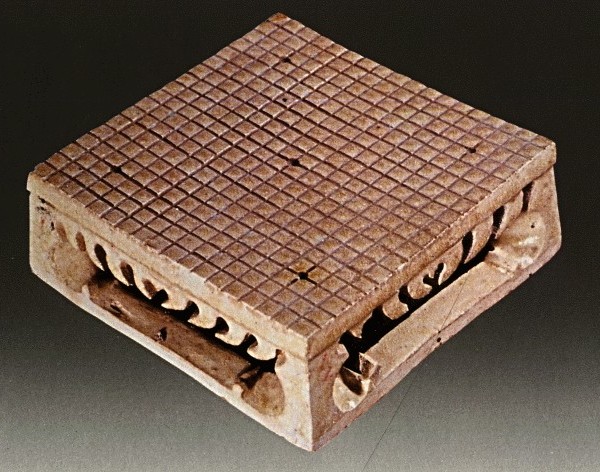
Source : Survey of Chinese Ceramics (Taibei, 1991) vol.2 page 171
Nevertheless, there is evidence that the 17 × 17 board remained in use to some extent into the Tang dynasty, especially in peripheral regions of the Chinese empire. For example, in this 7th century silk picture from Xinjiang, the board is shown as a 17 × 16 grid, which is probably a badly-drawn representation of a 17 × 17 board (the artist seems to have run out of space on the righthand side, so that the 16th vertical line is just squeezed in, but there is no room for the 17th) :
Tang Dynasty Silk painting of a Go player
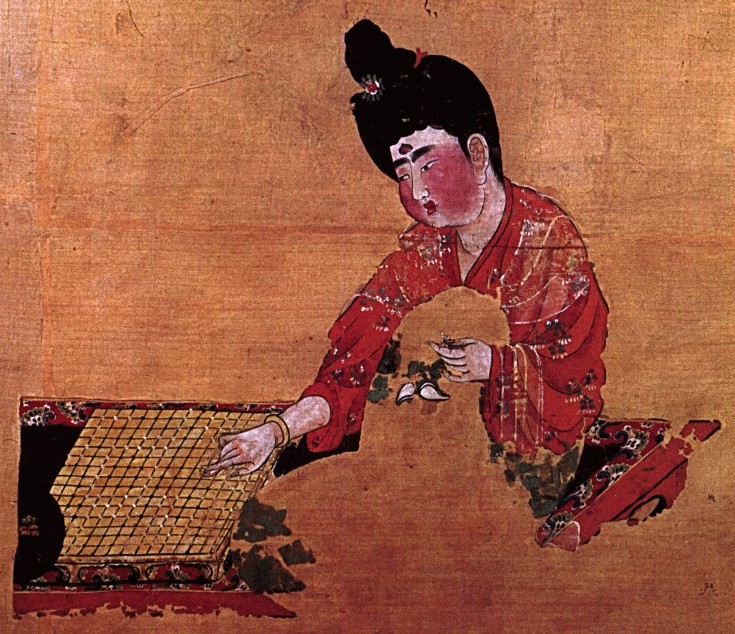
Non-standard boards (e.g. 13 × 13) continued to be used in addition to the standard 19 × 19 board for many more centuries, as I discuss in my post on Playing Go on a Chinese Chess Board.
See Also
Index of BabelStone Blog Posts
